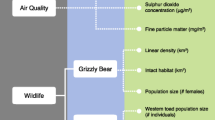Abstract
In environmental studies statistics is too often used as a salvage operation, or as an attempt to show ‘significance’ in the absence of any clear hypothesis. Good design is needed, not fancier statistics. Too often we pursue short-term problems that are in fashion rather than study long-term environmental deterioration that really matters. Since change-often unpredictable change-is an intrinsic part of nature, it is pointless to fight all environmental change. We must choose our level of concern and then influence environmental change where we can. The judgement on whether a given change is bad cannot be left to the statistician or to statistical tests; the politician in consultation with the ecologist are responsible for it. The statistical significance of a hypothesized impact-related change should be tested against year-to-year variation in the unimpacted situation rather than against replicate sampling error. This is another argument for long-term studies. Attributes of good design and appropriate criterion and predictor variables are discussed.
Similar content being viewed by others
References
Cabioch, L.: 1980, ‘Pollution of Subtidal Sediments and Disturbance of Benthic Animal Communities’, Ambio 9, 294–296.
Gilbert, B.: 1972, Gospel of False Prophets, Sports Illustrated.
Green, R. H.: 1979, Sampling Design and Statistical Methods for Environmental Biologists, Wiley, N.Y. 257 pp.
Green, R. H.: 1980, ‘Multivariate Approaches in Ecology: The Assessment of Ecologic Similarity’, Ann. Rev. Ecol. Syst. 11, 1–14.
J. Fish. Res. Board Can. 35(5), 1978.
Kaesler, R. L., Cairns, J. Jr., and Crossman, J. S.: 1974, ‘Redundancy in Data from Stream Surveys’, Water Res. 8, 637–642.
Laubier, L.: 1980, ‘The Amoco Cadiz Oil Spill: An Ecological Impact Study’, Ambio 9, 268–276.
Macdonald, J. S. and Green, R. H.: 1983, ‘Redundancy of Variables Used to Describe Importance of Prey Species in Fish Diets’, Can. J. Fish. Aquat. Sci. 40, 635–637.
Marzolf, G. R.: 1983, ‘LTER Aquatic Research’, Aquatic Ecology Newsletter of Ecol. Soc. Amer. 16, 5–6.
Sanders, H. L.: 1977, ‘Evolutionary Ecology and the Deep-sea Benthos’, in The Changing Scenes in Natural Sciences’, 1776–1976, Special Publ. 12, Acad. Natur. Sci., Philadelphia, pp. 223–243.
Sanders, H. L., Grassle, J. F., Hampson, G. R., Morse, L. S., Garner-Price, S., and Jones, C. C.: ‘Anatomy of an Oil Spill: Long-term Effects from the Grounding of the Barge Florida off West Falmouth, Massachussets’, J. Mar. Res. 38, 265–380.
Thurman, E. M.: 1983, ‘Multidisciplinary Research-an Experiment’, Envir. Sci. Technol. 17, 511A.
Author information
Authors and Affiliations
Rights and permissions
About this article
Cite this article
Green, R.H. Statistical and nonstatistical considerations for environmental monitoring studies. Environ Monit Assess 4, 293–301 (1984). https://doi.org/10.1007/BF00394147
Received:
Issue Date:
DOI: https://doi.org/10.1007/BF00394147




